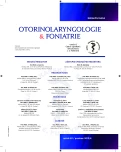Surgical Treatment of Salivary Glands Tumor Lesions in the Five-Year Period
Authors:
J. Lukáš 1,2; P. Janoušek 1; P. Jirák 1; M. Syrůček 3; J. Astl 1
Authors‘ workplace:
Oddělení ORL a chirurgie hlavy a krku, Nemocnice Na Homolce, Praha
1; Otorinolaryngologická klinika LF UK a FN v Plzni
2; Oddělení patologie, Nemocnice Na Homolce, Praha
3
Published in:
Otorinolaryngol Foniatr, 62, 2013, No. 4, pp. 180-185.
Category:
Original Article
Overview
Surgery plays and decisive role in the treatment of salivary glands tumor lesions. In retrospective analysis of 123 surgically treated patients we investigated, in addition to basic demographic categories, the occurrence of postoperative complications: facial nerve paralysis, salivary fistula, the Frey syndrome and tumor relapse. The comparison of postoperative results with cytological findings made it possible to evaluate validity of fine needle biopsy in preoperative diagnostics. The tumor lesions in the parotid gland occurred in 87 patients (70.7%), in the submandibular gland in 35 patients (28.5%) and once in the sublingual gland. The mean age of the patients operated on was 52.2 years, and there were 56 men (45.5 %) in the cohort. Malignant tumor was determined in 17 patients (13.8%) and benign one in 106 patients (86.2%). Pleiomorphic adenoma was the most frequent tumor found in 34 cases (27.6%). The conservative superficial parotidectomy was performed in 58 cases (47.2%). Two patients suffered from permanent postoperative paresis of facial nerve, three patients had tumor relapse and four patients experienced the Frey syndrome. The correlation of histopathology results with cytology findings revealed 85.3% sensitivity of aspiration cytology, 100% specificity and 90.1% diagnostic precision. If the tumor is localized in parotid gland parenchyma outside the presumed course of facial nerve and the size is < 20 mm, a simple extirpation is acceptable.
Keywords:
umor lesion of large salivary glands, fine needle aspiration biopsy
Sources
1. Afify, S. E., Maynard, J. D.: Carcinoma of the major salivary glands. Annals of the Royal College of Surgeons of England, 74, 1992, 3, s. 186-191.
2. Ayoub, O. M., Bhatia, K., Mal, R. K.: Pleomorphic adenoma of the parotid gland: is long-term follow up needed? Auris, Nasus, Larynx, 29, 2002, 3, s. 283-285.
3. Costas, A., Castro, P., Martin-Granizo, R., Monje, F., Marron, C., Amigo, A.: Fine needle aspiratio biopsy (FNAB) for lesions of the salivary glands. Br.-J.-Oral-Maxillofac.-Surg., 38, 2000, 5, s. 539-542.
4. Čáp, J., Ryška, A.: Aspiration cytology of the thyroid gland. NUCLEUS HK, 1. vydání, 2003, s. 31-41.
5. Henriksson, G., Westrin, K. M., Carlsoo, B., Silversward, C.: Recurrent primary pleomorphic adenomas of salivary glan origin. Cancer, 84, 1998, 4, s. 617-620.
6. House, J. W., Brackmann, D. E.: Facial nerve grading system. Otolaryngol. Head Neck Surg., 93, 1985, 2, s. 146-147.
7. Klijanienko, J., Vielh, P.: Fine-needle sampling of salivary gland lesions I. Cytology and histology correlation of 412 cases of pleomorphic adenoma. Diagnostic. Cytopathology, 14, 1996, 3, s. 195-200.
8. Lukáš, J., Astl, J., Soukup, J.: Primární extranodální non-Hodgkinovy lymfomy slinných žláz. Otorinolaryng.a Foniat./Prague/, 50, 2001, 4, s. 216-219.
9. Lukáš, J.: Nádory slinných žláz. Postgraduální medicína, 4, 2002, 9, s. 1012-1015.
10. Martins, C., Fonseca, I., Félix, A., Roque, L., Soares, J.: Ben ign salivary gland tumors: A cytogenetic study of 21 cases. Journal of Surgical Oncology, 60, 1995, 4, s. 232-237.
11. Orell, S. R.: Diagnostic difficulties in the interpretation of fine needle aspirates of salivary gland lesions: the problem revisited. Cytopathology, 1995, 6, s. 285-300.
12. Robbins, K. T., Clayman, G., Levine, P. A., Medina, J., Sessions, R., Shaha, A., Som, P., Wolf, G. T.: Neck dissection classification update: revisions proposed by the American Head and Neck Society and the American Academy of Otolaryngology-Head and Neck Surgery. Arch. Otolaryngol. Head Neck Surg., 128, 2002, 7, s. 751-758.
13. Stárek, I., Černý, L., Roderick, W. H., Simpson.: Choroby slinných žláz. Grada Publishing, spol. s r.o., Praha, 2000.
14. Stárek, I., Skálová, A., Tichý, T.: Histopatologic changes in parotid gland parenchyma after fine needle aspiration biopsy of a Warthin´s tumor. A case report. Pathology Research and Practice, 198, 2003, 12, s. 829-832.
15. Stella Chin, Shaw Tsai, Hsin-Te Hsu: Parotid neoplasms: diagnosis, treatment, and intraparotid facial nerve anatomy. The Journal of Laryngology&Otology, 116, 2002, 5, s. 359-362.
16. Stewart, C. J., MacKenzie, K., Mc Garry, G. W., Mowat, A.: Fine-needle aspiration cytology (FNAB) of salivary gland: A review of 341 cases. Dian. Cytopathol., 22, 2000, 3, s. 139-146.
17. Szanto, P. A., Luna, M. A., Torledo, M. E., White, R. A.: Histologic grading of adenoid cystic carcinoma of the salivary glands.Cancer, 54,1984, 6, s.. 1062-1069.
18. Verma, K., Kapila, K.: Role of fine needle aspiration cytology in diagnosis of pleomorphic adenomas. Cytopathology, 13, 2002, 2, s. 121-127.
19. Webb, A. J., Evenson, J. W.: Pleomorphic adenomas of the major salivary glands: a study of the capsular form in relation to surgical managment. Clin. Otolaryngol., 26, 2001, 2, s. 134-142.
20. Witt, R. L.: Minimally invasive surgery for parotid pleomorphic adenonoma. Ear, Nose&Throat Journal, 84, 2005, 5, s. 308-311.
Labels
Audiology Paediatric ENT ENT (Otorhinolaryngology)Article was published in
Otorhinolaryngology and Phoniatrics

2013 Issue 4
Most read in this issue
- Narrow Band Imaging (NBI) - Endoscopic Method for Head and Neck Squamous Cell Carcinoma Diagnostics
- Electrostimulation of Immobile Vocal Cord – Modification of the Method
- Surgical Treatment of Salivary Glands Tumor Lesions in the Five-Year Period
- Voice Range Profile Parameters in Diagnostics and Voice Research
